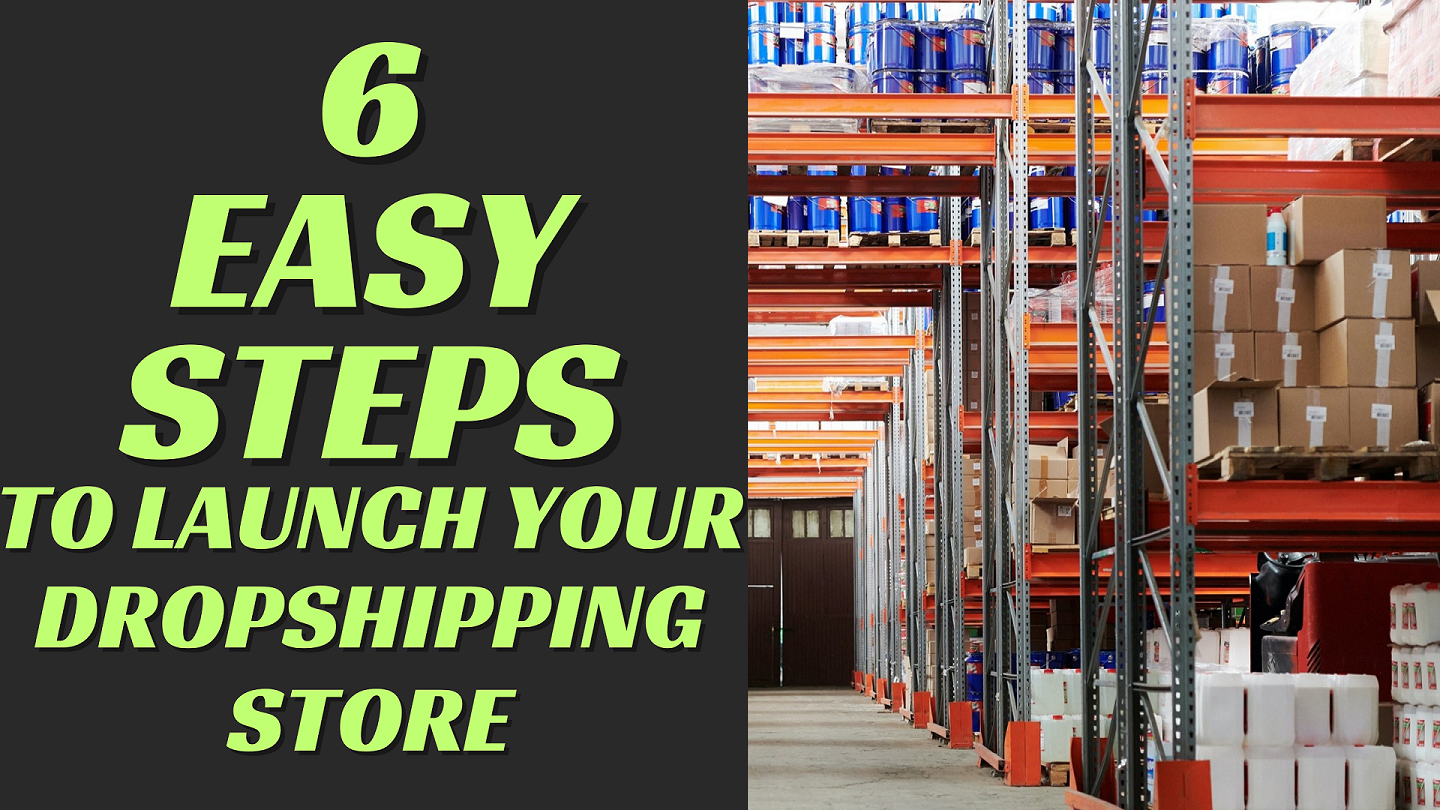Zero to Store: Launch Your Dropshipping Store in 6 Easy Steps

Table of Contents
Introduction to Dropshipping
The allure of being your boss, setting your hours, and building an online empire from your laptop – that’s the dream dropshipping promises. But how does it work, and more importantly, is it the path to entrepreneurial success? Let’s delve into the world of dropshipping and equip you with the knowledge to decide if it’s the right fit for you.

What is Dropshipping?
Imagine a business where you act as a middleman, connecting customers to products without ever seeing them yourself. That’s dropshipping in a nutshell. You list products on your online store, customers order them, and your supplier handles the rest – picking, packing, and shipping directly to your customers. It’s a low-overhead, inventory-free business model that’s tempting for aspiring entrepreneurs.
Central to the dropshipping narrative are three primary players – the retailer, the customer, and the supplier. The retailer acts as the orchestrator, curating an online storefront and handling customer interactions. The customer, the end-user, places orders through the retailer’s platform. The crucial third element is the supplier, responsible for housing inventory, processing orders, and directly delivering products to customers. This seamless collaboration among these players forms the bedrock of the dropshipping phenomenon.
The surge in e-commerce platforms has been a driving force behind the prominence of dropshipping. With the global shift towards online shopping, traditional retail models faced challenges, giving rise to innovative approaches like dropshipping. As consumers increasingly prefer the convenience of online purchases, the demand for efficient and scalable fulfillment methods has grown exponentially.
Inspiring Dropshipping Success Stories

Michael Chee – Michael Chee started his dropshipping business in 2014 with a $100 investment. He quickly found success by selling pet supplies and accessories. Within a few years, he was generating over $1 million in revenue per year. Chee’s success is attributed to his focus on providing excellent customer service and building a strong brand.
Andrew Youderian – Andrew Youderian started his dropshipping business in 2012 while he was still in college. He began by selling phone cases and accessories. Within a few years, he was generating over $1 million in revenue per year. Youderian’s success is attributed to his focus on finding high-quality products and building a strong online presence.
Ashley Nicole – Ashley Nicole started her dropshipping business in 2015 while she was working as a full-time teacher. She began by selling home goods and décor. Within a few years, she was able to quit her teaching job and focus on her dropshipping business full-time. Nicole’s success is attributed to her focus on building a strong brand and creating engaging content for her social media followers.
Chris Wane – Chris Wane started his dropshipping business in 2016 while he was living in his parents’ basement. He began by selling electronics and gadgets. Within a few years, he was generating over $1 million in revenue per year. Wane’s success is attributed to his focus on finding unique products and building a strong email marketing list.
Dan Dasilva – Dan Dasilva started his dropshipping business in 2017 while he was working as a full-time software engineer. He began by selling clothing and accessories. Within a few years, he was able to quit his engineering job and focus on his dropshipping business full-time. Dasilva’s success is attributed to his focus on building a strong brand and running paid advertising campaigns.
These are just a few of the many people who have achieved success in the dropshipping business. Their stories are a testament to the fact that anyone can start a successful dropshipping business with hard work and dedication.
6-Steps Guide to Building Dropshipping Business

1. List Products:
- Find your niche: Identify a specific market with passionate customers and limited competition. Research trends, analyze existing brands, and consider your interests.
- Seek quality suppliers: Explore platforms like SaleHoo or Spocket for reliable sources with diverse product ranges. Analyze factors like shipping times, minimum order quantities, and customer reviews.
- Craft your product selection: Choose high-quality items that resonate with your niche and brand identity. Don’t oversaturate your store – start with a curated collection and expand carefully.
- Optimize product descriptions: Write detailed and engaging descriptions that highlight product features, benefits, and specifications. Use high-quality product images and videos to showcase your offerings.
2. Create Your Store:
- Platform selection: Compare popular options like Shopify, Wix, and BigCommerce based on ease of use, features, scalability, and budget. Consider integrations with marketing tools and payment gateways.
- Design and branding: Create a visually appealing and user-friendly website that reflects your brand identity. Choose a clear layout, navigation structure, and color scheme.
- Product pages: Optimize product pages for mobile devices and search engines. Ensure they include product details, variations, clear calls to action, and customer reviews.
- Checkout process: Streamline the checkout process for a smooth customer experience. Offer multiple payment options and ensure secure transactions.
3. Market & Sell:
- SEO optimization: Research relevant keywords and implement them in your website content and product descriptions. Build backlinks and ensure your store is mobile-friendly to improve search engine rankings.
- Social media marketing: Engage your target audience on platforms like Instagram, Facebook, and TikTok. Share engaging content, run promotions, and build a community around your brand.
- Paid advertising: Utilize platforms like Google Ads and Facebook Ads to reach a wider audience with targeted campaigns. Experiment with different ad formats and track performance to optimize your budget.
- Email marketing: Build an email list and send targeted campaigns to promote new products, special offers, and abandoned cart recovery. Provide valuable content and avoid spamming your customers.
4. Order Fulfillment:
- Communicate clearly: Establish clear communication protocols with your supplier about order processing, packaging, and shipping. Specify branding requirements and ensure accurate shipping information.
- Track orders: Implement a system to track orders from placement to delivery. Keep customers informed of order status updates and provide transparent timelines.
- Returns and refunds: Establish clear return and refund policies for damaged or faulty products. Ensure a smooth and hassle-free customer experience in case of issues.
5. Profit Margins:
- Price competitiveness: Research market prices for similar products and set competitive retail prices that factor in your wholesale cost and desired profit margin.
- Offer promotions and discounts: Strategically use promotions and discounts to attract new customers and boost sales without sacrificing profit margins.
- Analyze and optimize: Track your sales data and profit margins to identify areas for improvement. Adjust pricing strategies and product offerings based on data insights.
6. Customer Service:
- Responsive communication: Be readily available to answer customer inquiries through email, live chat, or phone. Respond promptly and professionally to all queries and concerns.
- Resolve issues efficiently: Dedicate time and resources to resolving customer issues promptly and efficiently. Aim to exceed expectations and build trust with your customers.
- Value feedback: Encourage customer feedback and actively listen to their suggestions. Utilize constructive feedback to improve your products, services, and overall customer experience.
Success in dropshipping requires a multifaceted approach. Expanding on these steps and tailoring them to your specific niche and business goals will give you a strong foundation for building a thriving online store.
Building Dropshipping Store

The thrilling part of dropshipping is building your online storefront, the digital haven where your passion meets profit. Your first step: crafting a website that converts visitors into loyal customers. Here’s a quick guide to get you started:
1. Choose Your Hosting Provider:
While there are several hosting providers like Hostinger, GoDaddy, Bluehost, etc. which provide excellent service, I prefer and use Hostinger as I found it most economical among the high-reliability providers. If you would like to sign up for Hostinger, please use my referral link: https://hostinger.in?REFERRALCODE=1SWADHIN91
2. Pick a Hosting Plan:
- Shared Hosting: Budget-friendly for low-traffic stores, perfect for initial launch.
- Cloud Hosting: As your business grows, upgrade to cloud hosting for increased reliability and scalability.
3. Secure Your Domain Name:
Your store’s digital address! Grab a catchy, brand-relevant domain name using your platform’s search tool.
4. Design and Brand Your Masterpiece:
Make your store visually appealing and user-friendly.
- WordPress + WooCommerce: For power users who crave customization, WordPress reigns supreme. Add the WooCommerce plugin and transform your site into a robust e-commerce hub. Plugins like Elementor let you design every pixel.
- Website Builders: Prefer drag-and-drop simplicity? Choose a platform like Wix or Squarespace. Templates and built-in tools make web design a breeze.
5. Essential Pages:
- Homepage: Captivate visitors with your brand story and top products.
- Product Pages: Entice customers with high-quality images, detailed descriptions, and clear pricing.
- About Us: Build trust and connection by sharing your values and team.
- Contact Us: Make it easy for customers to reach you with a contact form and clear information.
Bonus Tip: Optimize your website for search engines (SEO) and marketing. Tools and resources from your platform can help you rank higher and attract more customers.
Remember, building a successful dropshipping website requires dedication and learning. Take your time, utilize available resources, and watch your entrepreneurial dream take flight!
Selecting Dropshipping Platform

Most Popular Platforms for Dropshipping Store:
- Shopify: User-friendly with a vast app store and strong e-commerce focus.
- Wix: Easy drag-and-drop interface and affordable plans.
- BigCommerce: Scalable platform for larger businesses with advanced features.
Beyond the Big Three:
- WooCommerce: Open-source plugin for WordPress, offering flexibility and control for tech-savvy entrepreneurs. Requires hosting and theme customization.
- Squarespace: Stylish templates and built-in SEO tools, ideal for creatives and design-focused brands. Limited app integrations compared to Shopify.
- Ecwid: Free plan available for small businesses, integrates with existing websites and social media platforms. Limited scalability for larger volumes.
- Big Cartel: Simple and affordable platform for artists and independent creators, perfect for selling individual products or small collections.
Choosing the Right Platform:
- Consider your needs: Beginner-friendly? Scalable for growth? Integration with specific marketplaces?
- Budget: Free plans, affordable monthly subscriptions, or custom hosting costs?
- Features: App store, marketing tools, built-in analytics, SEO capabilities?
- Target audience: Does the platform cater to your niche and customer base?
The best platform depends on your specific needs and goals. Research, compare, and choose the one that empowers you to build a successful dropshipping business.
Bonus Tip: Explore platforms offering free trials or demos to test-drive their features before committing.
Selecting Dropshipping Supplier

Choosing the right supplier is like planting the seed for your success. They hold the key to high-quality products, seamless fulfillment, and happy customers. So, how do you navigate the vast landscape of dropshipping suppliers and find the perfect match for your blossoming business? Here’s a comprehensive guide to help you make informed decisions:
1. Know Your Niche:
Before diving into supplier pools, define your niche. Are you selling trendy fashion accessories, eco-friendly homeware, or personalized tech gadgets? Understanding your niche will guide you toward suppliers specializing in relevant products.
2. Prioritize Quality:
Never compromise on quality! Choose suppliers with a proven track record of offering reliable, durable products that meet your customers’ expectations. Positive customer reviews, industry certifications, and detailed product descriptions are good indicators.
3. Fulfillment Matters:
Fast and efficient shipping is critical in e-commerce. Look for suppliers with strategically located warehouses near your target audience, offering multiple shipping options and real-time tracking. Minimizing shipping delays builds trust and keeps customers coming back.
4. Price & Profit:
Finding the right balance between competitive pricing and healthy profit margins is crucial. Compare wholesale prices across different suppliers to get the best deals without sacrificing quality. Remember to factor in shipping costs and potential return rates when calculating your overall profit margin.
5. Communication & Support:
Open communication is key to a smooth dropshipping operation. Choose suppliers who offer responsive customer support, clear order processing procedures, and proactive communication regarding inventory updates or shipping delays.
Top Dropshipping Suppliers with Excellent Ratings:
General Suppliers:
- Spocket: Integrates seamlessly with Shopify and BigCommerce, focusing on US and EU suppliers with fast shipping and low minimum orders.
- SaleHoo: Directory of verified dropshipping suppliers, offering research tools and product sourcing services.
- Doba: Features vetted wholesale suppliers with bulk discounts and private labeling options, suitable for experienced dropshippers.
- Wholesale Central: Extensive directory of US-based wholesalers across various categories, offering competitive prices and reliable fulfillment.
Niche-Specific Suppliers:
- Printful: Print-on-demand dropshipping for t-shirts, mugs, phone cases, and more.
- Teelaunch: Another print-on-demand platform with a wider range of customizable products and apparel options.
- Oberlo: Integrates with Shopify and AliExpress, offering an easy-to-use interface for sourcing products from China.
- Dropis: Focuses on European suppliers for faster shipping times and better product quality within the EU market.
Remember:
- This is not an exhaustive list. Research and compare different suppliers within your niche for the best fit.
- Read supplier reviews and testimonials to get an unbiased perspective on their services.
- Don’t be afraid to reach out to potential suppliers and ask questions to ensure they align with your business needs.
By carefully selecting your dropshipping supplier, you lay the foundation for a successful and sustainable online business.
Conclusion
Dropshipping offers a low-risk entry point into the world of e-commerce, but it’s not a guaranteed path to riches. Success requires hard work, dedication, and strategic planning. Remember, building a profitable drop shipping business takes time and effort. It’s about building a brand, acquiring loyal customers, and providing excellent service. So, if you’re willing to put in the work and learn from your mistakes, dropshipping might just be the key to unlocking your entrepreneurial dreams.
Start your research, find your niche, and prepare to navigate the exciting world of online business. Remember, even small steps can lead to big leaps – your dropshipping success story might just be around the corner.
Here in bracket ( https://rechargeinspiration.com/business-ideas-vault/ ) is the link to Our Business Ideas Vault where you can find many more business ideas. We hope that you will find the one that will bring you success and happiness.